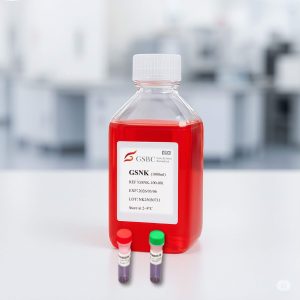Product Details
- Product Name: PriGrow III Medium
- Product Type: Medium
- Catalog Number: TM003
- Unit Size: 500 mL
- Formulation: Serum-free and antibiotic-free basal medium
- Appearance: Liquid
- pH Range: 7.0-7.4
- Osmolarity: 315-350 mOsm/kgH₂O
- Endotoxin Level: ≤ 1 EU/mL
- Sterility: Pass
- Storage Condition: 4-8°C
- Shipping Condition: Shipped on ice packs
Overview
PriGrow III Medium is a high-performance basal medium specifically designed for mammalian cell culture applications. This medium provides researchers with a flexible and customizable platform, allowing the addition of specific growth factors, sera, or antibiotics as needed. Each batch undergoes rigorous quality control testing to ensure optimal sterility, pH balance, osmolality, and minimal endotoxin levels.
PriGrow III is ideal for a wide range of research applications, including primary cell culture, immortalized cell line expansion, and specialized studies in cell differentiation, metabolism, and signaling pathways.
Key Features and Benefits
- Serum-Free and Antibiotic-Free: Enables flexibility for various research applications and experimental designs.
- Optimized for Mammalian Cell Growth: Supports consistent and reproducible performance across different cell types.
- High Purity and Low Endotoxin Levels: Ensures minimal contamination risk and supports sensitive cell cultures.
- Customizable Supplementation: Can be tailored with additional components such as growth factors and serum for specific research needs.
- Batch-to-Batch Consistency: Each lot is rigorously tested for sterility, pH balance, osmolality, and adherence to strict quality standards.
Key Ingredients and Special Additives
- L-Glutamin: 5.84 mM
- D-Glucose: 27.48 mM
- L-Cysteine: < 0.2 mM
Quality Control (QC)
Each batch of PriGrow III Medium undergoes strict quality control processes to maintain the highest standards for cell culture performance. QC assessments include:
- Cell Culture Performance: Evaluation of adherence rate (if applicable), morphology, and metabolic activity of tested cell lines.
- Sterility Testing: Ensures a contamination-free environment for optimal cell growth.
- Physicochemical Properties: pH balance and osmolality testing for consistency.
- Endotoxin Screening: Confirms minimal endotoxin presence to safeguard cell viability.
Caution
For research use only. This product is not intended for therapeutic, diagnostic, or clinical applications. It is strictly for laboratory research purposes and should not be used in humans.
Disclaimer
- This product is designed exclusively for laboratory research use and is not approved for human or medical applications.
- The manufacturer makes no warranties regarding the accuracy, completeness, or suitability of this product beyond its intended research use.
- Any referenced literature or third-party citations are provided for informational purposes only and do not imply validation or endorsement of specific results.
References
- Soo Kim, Beob, et al. “Human collagen‐based multilayer scaffolds for tendon‐to‐bone interface tissue engineering.” Journal of Biomedical Materials Research Part A 102.11 (2014): 4044-4054.
- Chesnokova, Vera, et al. “Growth hormone is a cellular senescence target in pituitary and nonpituitary cells.” Proceedings of the National Academy of Sciences 110.35 (2013): E3331-E3339.
- Ravikumar, Priya, et al. “α-Klotho protects against oxidative damage in pulmonary epithelia.” American Journal of Physiology-Lung Cellular and Molecular Physiology 307.7 (2014): L566-L575.
- Kim, Jeonghan, et al. “The role of heat shock protein 90 in migration and proliferation of vascular smooth muscle cells in the development of atherosclerosis.” Journal of molecular and cellular cardiology 72 (2014): 157-167.
- Xu, Zhihao, et al. “MicroRNA‐381 Negatively Regulates TLR4 Signaling in A549 Cells in Response to LPS Stimulation.” BioMed research international 2015.1 (2015): 849475.
- Kang, Seok-Seong, et al. “Staphylococcus aureus induces IL-8 expression through its lipoproteins in the human intestinal epithelial cell, Caco-2.” Cytokine 75.1 (2015): 174-180.
- Kang, Hyreen, et al. “Magnobovatol inhibits smooth muscle cell migration by suppressing PDGF-Rβ phosphorylation and inhibiting matrix metalloproteinase-2 expression.” International Journal of Molecular Medicine 37.5 (2016): 1239-1246.
- Kim, Jeonghan, et al. “The role of heat shock protein 90 in migration and proliferation of vascular smooth muscle cells in the development of atherosclerosis.” Journal of molecular and cellular cardiology 72 (2014): 157-167.
- Lin, Yu‐Sheng, et al. “Liver X receptor/retinoid X receptor pathway plays a regulatory role in pacing‐induced cardiomyopathy.” Journal of the American Heart Association 8.1 (2019): e009146.
- Xu, Zhihao, et al. “MicroRNA‐381 Negatively Regulates TLR4 Signaling in A549 Cells in Response to LPS Stimulation.” BioMed research international 2015.1 (2015): 849475.



